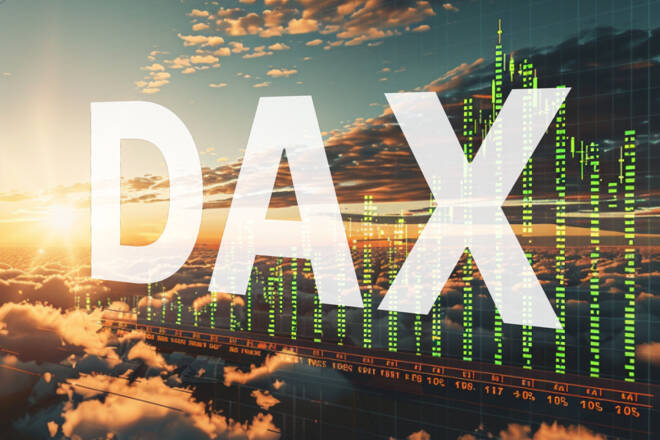Advertisement
Advertisement
DAX Index Today: Investors Eye German GDP, Inflation as the Fed Decision Looms
By:
Key Points:
- The DAX declined by 0.53% on Monday, July 29, ending the session at 18,321.
- Corporate earnings, German GDP, and inflation figures will draw investor interest on Tuesday, July 30.
- Later in the session on Tuesday, US consumer confidence and labor market data will also require consideration.
Market Overview
On Monday, July 29, the DAX declined by 0.53%. Partially reversing a 0.65% gain from Friday, July 26, the DAX ended the session at 18,321.
Monday: DAX Market Movers
- Auto stocks contributed to the losses, with Mercedes Benz Group sliding by 1.78%, while BMW declined by 1.12%.
- Deutsche Bank downgraded Stellantis from ‘Buy’ to ‘Hold,’ impacting auto stock demand.
- Banking stocks also trended lower, with Commerzbank and Deutsche Bank seeing losses of 1.26% and 0.69%, respectively, as investors awaited the Fed.
German GDP and Inflation: Impact Analysis
German GDP and inflation figures will influence ECB rate cut bets and market risk sentiment on Tuesday, July 30.
Economists forecast the German economy to expand by 0.1% in Q2 2024 after 0.2% growth in Q1 2024.
An unexpected contraction could signal a weakening demand environment, supporting a softer inflation outlook.
However, German inflation numbers will likely impact DAX-listed stocks more.
Economists expect the annual inflation rate to remain at 2.2% in June. Softer-than-expected numbers could fuel investor bets on September and December ECB rate cuts.
A more dovish ECB rate path could reduce borrowing costs and possibly improve company profits.
German Corporate Earnings Reports
Beyond the German economic calendar, corporate earnings are also crucial.
Marck & Co, Covestro, and Airbus are among the names to report earnings. Weak earnings and gloomy forecasts could adversely impact market risk sentiment.
Meanwhile, investors remain optimistic about a September Fed rate cut.
Dallas Fed Manufacturing Signals Weaker Economic Activity
On Monday, July 29, the Dallas Fed Manufacturing Index unexpectedly fell from -15.1 in June to -17.5 in July. Weaker-than-expected numbers supported investor bets on a September Fed rate cut.
Charles Schwab Senior Investment Strategist Kevin Gordon commented on the July Report, stating,
“New cycle low for average employee workweek component in the Dallas Fed Manufacturing Index as of July.”
However, the numbers failed to fuel buyer appetite for riskier assets. Investors turned cautious ahead of the Fed interest rate decision and the highly anticipated press conference.
US Market Trends
The US equity markets had a mixed Monday session despite 10-year US Treasury yields dipping by 18 basis points to 4.176%.
The Nasdaq Composite Index and the S&P 500 gained 0.07% and 0.08%, respectively, while the Dow fell by 0.12%.
US Economic Data
On Tuesday, July 30, US consumer confidence and labor market data may influence market risk sentiment.
US Consumer Confidence
Economists forecast the CB Consumer Confidence Index to drop from 100.4 in June to 99.9 in July. Weakening consumer confidence may signal a pullback in consumer spending, dampening demand-driven inflation. A softer inflation outlook could enable the Fed to cut rates in September and December.
However, investors should consider the Expectations Index, sitting below 80 for five successive months. According to The Conference Board, an Index below 80 has previously signaled an economic recession. The Expectations Index declined from 74.9 in May to 73.0 in June.
US JOLTs Job Openings
Economists forecast JOLTS Job Openings to fall from 8.14 million in May to 8.05 million in June. A lower-than-expected number could raise investor bets on multiple 2024 Fed rate cuts. Downward trends in disposable income may curb consumer spending.
Multiple 2024 Fed rate cuts could reduce borrowing costs and improve company profits, supporting buyer demand for DAX-listed stocks.
What the Experts Say
Arch Capital Global Chief Economist Parker Ross commented on the previous JOLTS Report, stating,
“Although the May Job Openings and Labor Turnover Survey (JOLTS) showed slightly more job openings than expected (8.14m vs 7.95m consensus), the broader underlying downtrends remained in place. […]. The uptick in May merely kept the smoothed series from decelerating more quickly.”
Near-Term Outlook
Near-term DAX trends will depend on corporate earnings, Euro area inflation numbers, and the Fed press conference. Weaker-than-expected Euro area inflation numbers and Fed support for multiple 2024 rate cuts could drive demand for riskier assets. However, corporate earnings and forecasts will also influence market risk sentiment.
In the futures markets, the DAX was up by 3 points, while the Nasdaq mini was down by 30 points.
Investors should remain vigilant with corporate earnings, economic data, and monetary policy in focus. Monitor the news wires, economic data, and expert commentary to manage trading strategies. Stay up-to-date with our latest news and analysis to manage risk.
DAX Technical Indicators
Daily Chart
The DAX sat below the 50-day EMA while holding above the 200-day EMA, sending bearish near-term but bullish longer-term price signals.
A breakout from the 50-day EMA would support a move toward the 18,500 handle. A DAX return to the 18,500 handle could give the bulls a run at 18,750.
German economic data, corporate earnings, and the US economic calendar require consideration.
Conversely, a DAX drop below 18,200 could signal a fall toward 18,000.
The 14-day RSI at 47.93 indicates a DAX drop below 18,000 before entering oversold territory.
4-Hourly Chart
The DAX remained below the 50-day EMA while hovering above the 200-day EMA, affirming the bearish near-term but bullish longer-term price signals.
A break above the 50-day EMA would support a return to 18,500.
However, a DAX drop below the 200-day EMA could signal a fall toward 18,000.
The 14-period 4-hour RSI at 46.26 suggests a DAX fall to 18,000 before entering oversold territory.
About the Author
Bob Masonauthor
With over 28 years of experience in the financial industry, Bob has worked with various global rating agencies and multinational banks. Currently he is covering currencies, commodities, alternative asset classes and global equities, focusing mostly on European and Asian markets.
Did you find this article useful?
Latest news and analysis
Advertisement
